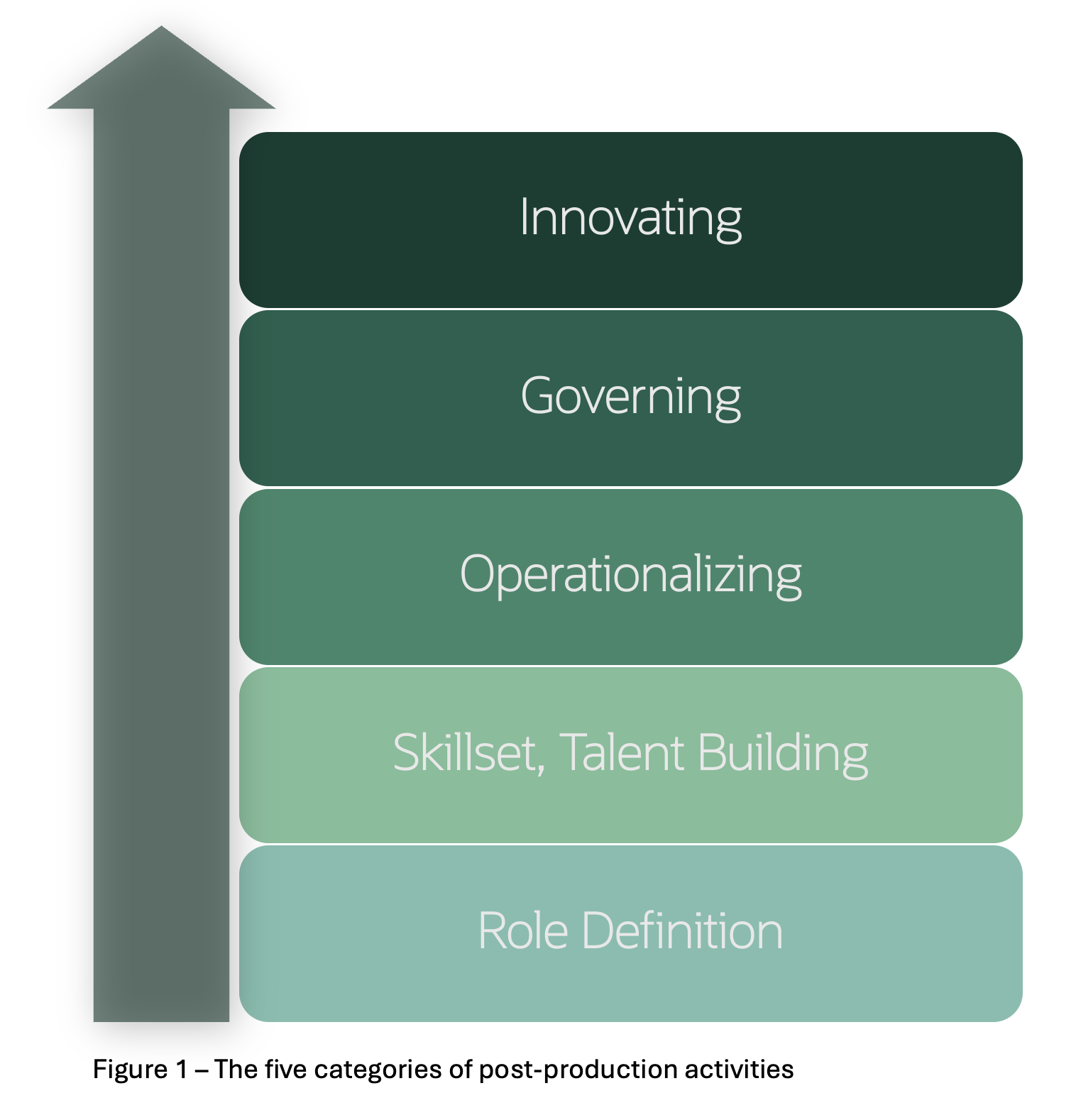Charting the Course After “Go-Live”: Your Journey Really Begins
The thrill of a successful cloud implementation, finally reaching “go-live”, is a milestone worth celebrating. But what happens next? Many organizations fall into the trap of thinking the hard work is over, when in fact, the real journey is just beginning, and success depends on preparing well before you reach that finish line. To deliver lasting value from your SaaS (Software as a Service) investment, you must start building your post-production strategy early: preparing your teams, aligning your operations, and creating a culture of ongoing innovation long before go-live. Navigating this journey is easier with a trusted partner; Oracle Customer Success Services (CSS) brings the playbook, the pit crew, and the experience to keep you racing ahead. Let’s dive into the five critical steps that will shape your post-production success and inspire your organization not just to survive after go-live, but to truly thrive.
 |
1. Redefining Roles: Who Does What, and Why It Matters
Clarity empowers teams and prevents confusion. One of the most overlooked challenges in the cloud journey is clarifying who does what once you’re live. In the legacy on-premises world, responsibilities were clearer – IT handled the tech and business owned the process. In SaaS, those lines blur. Anyone with the right permissions and a few quick clicks can change configurations and impact critical business operations. The essential lesson?
You must intentionally define roles. Ask:
- What will the business own?
- What stays with IT?
- Where do external partners fit?
- Who has the vigor, rigor, and skill to manage configurations, security, or integrations?
There’s no one-size-fits-all answer, but clarity is key. Consider creating a “responsibility matrix” (even a simple version) to spell out exactly who is executing each major activity. Role definition is the foundation everything else is built on.
2. Building Skills Beyond Technical Know-How
Versatile teams are ready for change and growth. Once roles are set, the next step is making sure your team has the abilities they’ll need, not just today, but as your environment evolves. While technical and functional expertise in Oracle is vital, your journey demands a broader skill set:
- Business Process Execution: Help desk staff and operational users alike need deep familiarity with daily tasks (think payroll or financial close).
- Change Management: As SaaS is updated frequently, teams must be ready to embrace change and learn continuously, tools (like Oracle Guided Learning) can help.
- Use of Tools: Ensure you have the right ticketing, monitoring, and enhancement processes in place to keep your teams effective and proactive.
Remember, not every skill needs to live in-house. Strategic use of specialized partners, like Oracle CSS, can supplement your team’s capabilities, especially in niche technical areas or during peak demand, ensuring you always have access to the right expertise when it matters most.
3. Organizing for Operational Excellence: The Tiered Approach
Structure streamlines problem solving and boosts efficiency. With the right people and skills in place, you must now organize for action. Think of your post-production support as a relay race, issues and opportunities should flow smoothly from one expert to the next, without falling through the cracks. Best practice is to use a “tiered” support model, adapted to your size and complexity:
- Tier 0: Self-service tools, knowledge bases, job aids, guided learning, accessible 24/7.
- Tier 1: Front-line help, which might be IT, a business help desk, or even an email group in smaller organizations.
- Tiers 2 & 3: Deeper expertise, whether internal or via partners, focused on more complex problem-solving.
Don’t expect perfection out of the gate; right after go-live, issues may “bleed” to higher tiers. Your goal, over time, is to left-shift, empowering self-service and reducing escalations so your teams can focus on more value-adding work. This is especially crucial for organizations with multiple geographies, time zones, or varying business units.
4. Governance That Drives Real Results
Effective oversight turns good intentions into measurable outcomes. Every organization claims to have “governance”, but in SaaS, effective governance is the difference between meeting expectations and unlocking best-in-class outcomes. True governance covers three interlocking areas:
- System Operations: Maintain up-to-date runbooks and documentation (like Oracle’s E-Business Suite (EBS) methodology “Functional Design” (MD50) and “Technical Design” (MD70) documents) to ensure teams know how systems are meant to function. These documents need to be living, updated as your configuration changes.
- Application Core: Guard quality by focusing on data, security, and master data governance. Remember, moving to SaaS brings new considerations, such as understanding where your data resides (to meet regulations or policies) and how your cloud applications connect and share information with other systems (integration touchpoints).
- Team Operations: Incident management, metric tracking, and a focus on reducing the cost and time associated with issue resolution. Use dashboards to provide real-time visibility and drive decisions.
A memorable insight from the experts: “Every ticket that moves through a level has a cost.” Invest in the processes and tooling to get the right issues solved at the right level, every time.
5. Making Innovation Routine, Not Random
Proactive innovation is a habit, not a one-off event. The true power of cloud applications lies in continuous innovation. Oracle, like many leading SaaS providers, releases new features on a frequent basis (quarterly for most apps, monthly for some). To capitalize on this, organizations need an explicit “innovation game plan”, not just to keep up, but to get ahead.
- Empower an Innovation Manager: This role coordinates impact assessments for every release, champions new features, and works closely with business stakeholders to drive adoption.
- Support with Specialized Teams: From testing and automation to monitoring and enhancement, dedicate resources (internal or partner-driven) to evaluate and implement innovation.
- Functional Meets Technical: Align business process owners (“pillar leads”) with IT, ensuring every update is viewed through the lens of business value, not just technical feasibility.
To maximize the benefits of Oracle’s quarterly innovation cycles, customers must be prepared to quickly assess, adopt, and operationalize new features and enhancements. As structural support, ensure you have strong project management, clear executive sponsorship, and, where appropriate, leverage trusted partners for specialist or high-volume tasks.
A Final Word: Prepare Today for Tomorrow’s Success
Regardless of organization size, whether you’re a nimble start-up or a sprawling multinational, the five essentials outlined above form the backbone of sustained post-implementation success. The extent and complexity may vary, but the importance never does.
Key steps to reflect on:
- Start your post-production planning early, before go-live.
- Customize the framework to fit your organization: your people, your process, your partner mix.
- Focus on user adoption and measurable business outcomes, not just technical stability.
- Remember: the success of technology is user adoption, it’s your KPIs, your ROI.
Your SaaS journey doesn’t stop at go-live; that’s simply the beginning of unlocking value. Invest in your people, your framework, and your culture of innovation. The results will speak for themselves.
Unlock Your Cloud’s True Potential
Start a conversation with your team: “How prepared are we for life after go-live?” Review your role definitions, skills, and operational model. If you find gaps, act now, because the most successful organizations see post-production as a phase of opportunity, not just maintenance. Success after going live doesn’t happen by accident, it’s built on smart strategy, strong partnerships, and a commitment to continuous improvement.
Oracle CSS delivers the expert guidance, seamless operations, and proven best practices you need to adapt, innovate, and realize the full value of your cloud investment. With CSS, you gain deep expertise, faster resolutions, and a partner dedicated to keeping your organization ahead as technology and business needs evolve. Now is the time to unlock lasting value and accelerate innovation. Connect with your Oracle Customer Success Manage or click the “Get Started with CSS – Contact Us” button to discover how Oracle CSS helps navigate these five key areas.

